Only the other week I had to fix my leaky tap. That was a nightmare. I cannot begin to imagine how you deal with a leaky spacecraft! In August 2020 Russia announced that their Zvezda module had an air leak. An attempt was make to fix it but in November 2021 another leak was found. Earlier this week, Russia announced the segment is continuing to leak but the crew are in no danger.
Continue reading “The International Space Station’s Air Leaks are Increasing. No Danger to the Crew”Russian Crowdfunded Satellite May Soon Become Brightest “Star” in the Sky
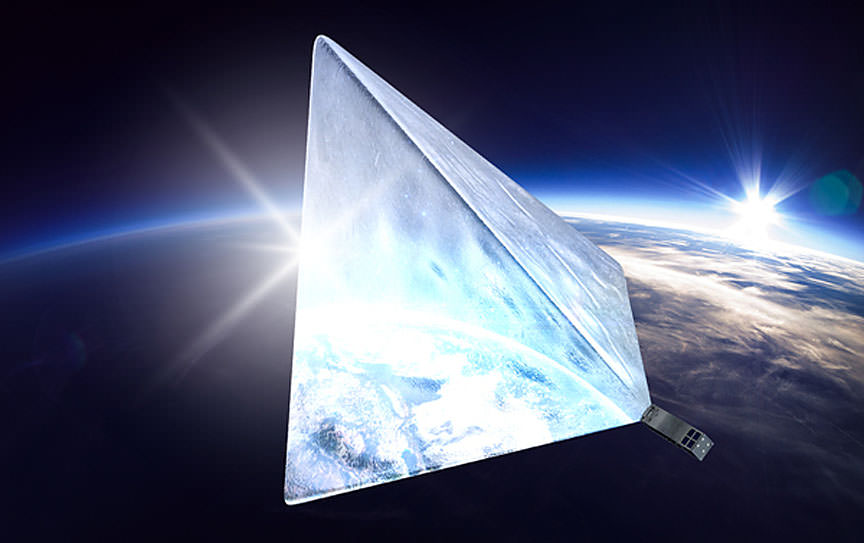

We may soon look up and see a satellite brighter than the space station and even Venus gliding across the night sky if a Russian crowdfunding effort succeeds. An enthusiastic team of students from Moscow University of Mechanical Engineering are using Boomstarter, the Russian equivalent of Kickstarter, to raise the money needed to build and launch a pyramid-shaped satellite made of highly reflective material they’re calling Mayak, Russian for “Beacon”.
Young engineers at Moscow University explain the Mayak Project
To date they’ve collected more than $23,000 or 1.7 million rubles. Judging from the video, the team has built the canister that would hold the satellite (folded up inside) and performed a high-altitude test using a balloon. If funding is secured, Beacon is scheduled to launch on a Soyuz-2 rocket from the Baikonur Cosmodrome in the second quarter of this year.
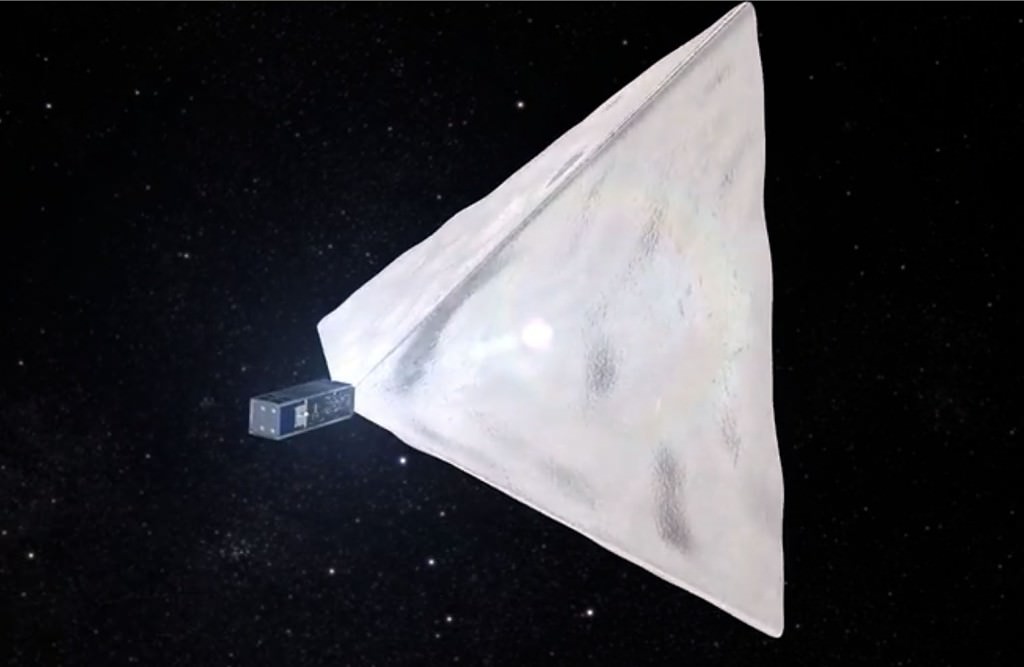
Once in orbit, Beacon will inflate into a pyramid with a surface area of 172 square feet (16 square meters). Made of reflective metallized film 20 times thinner than a human hair, the satellite is expected to become the brightest man-made object in orbit ever. That title is currently held by the International Space Station which can shine as brightly as magnitude -3 or about three times fainter than Venus. The brightest satellites, the Iridiums, can flare to magnitude -8 (as bright as the crescent moon) but only for a few seconds before fading back to invisibility. They form a “constellation” of some 66 satellites that provide data and voice communications.
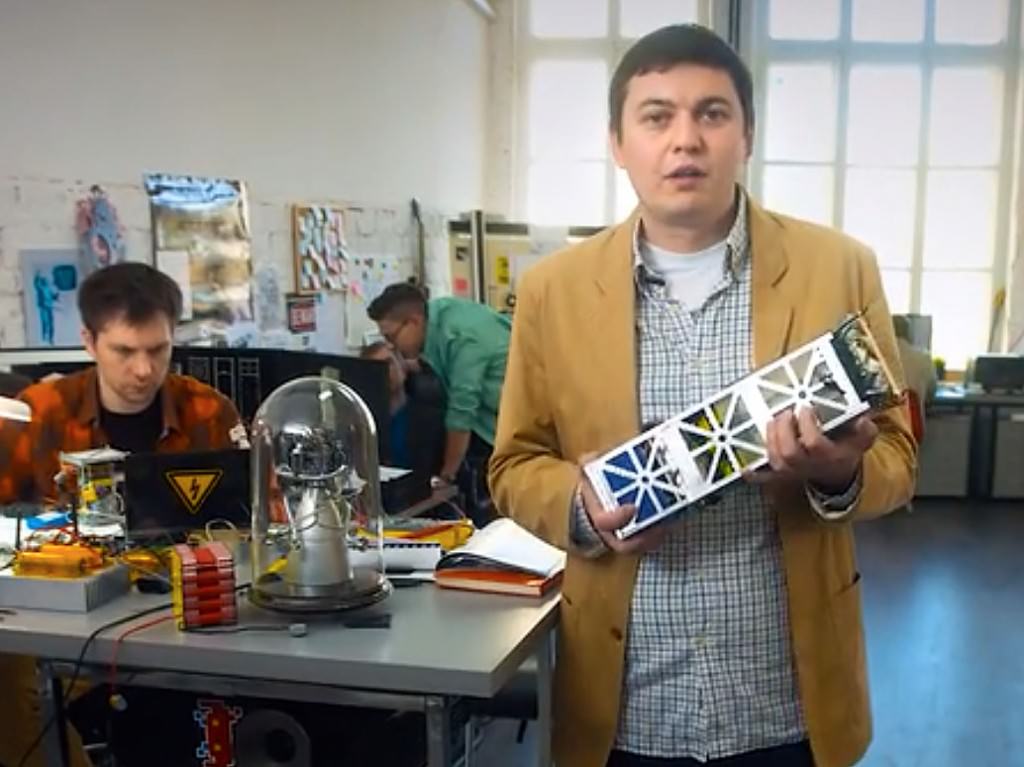
A concurrently-developed mobile app would allow users to know when Beacon would pass over a particular location. The students hope to achieve more than just track a bright, moving light across the sky. According to their website, the goal of the project is the “popularization of astronautics and space research in Russia, as well as improving the attractiveness of science and technology education among young people.” They want to show that almost anyone can build and send a spacecraft into orbit, not just corporations and governments.
Further, the students hope to test aerodynamic braking in the atmosphere and find out more about the density of air at orbital altitudes. Interested donors can give anywhere from 300 rubles (about $5) up 300,000 ($4,000). The more money, the more access you’ll have to the group and news of the satellite’s progress; the top donor will get invited to watch the launch on-site.
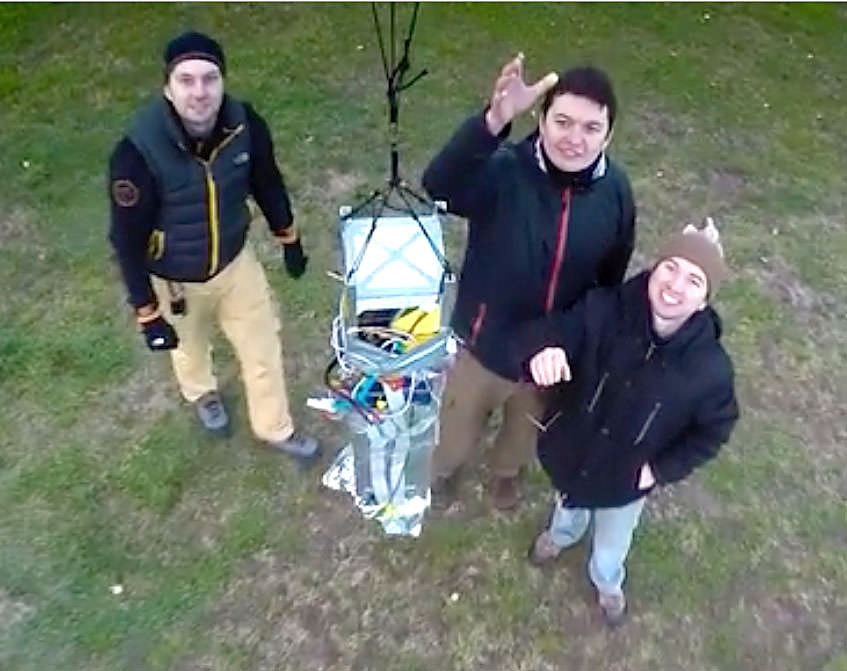
Once finished with the Mayak Project, the team wants to built another version that uses that atmosphere for braking its speed and returning it — and future satellites — safely back to Earth without the need for retro-rockets.
I think all these goals are worthy, and I admire the students’ enthusiasm. I only hope that satellite launching doesn’t become so cheap and popular that we end up lighting up the night sky even further. What do you think?
Want to be an Astronaut? Learn How to Speak Russian
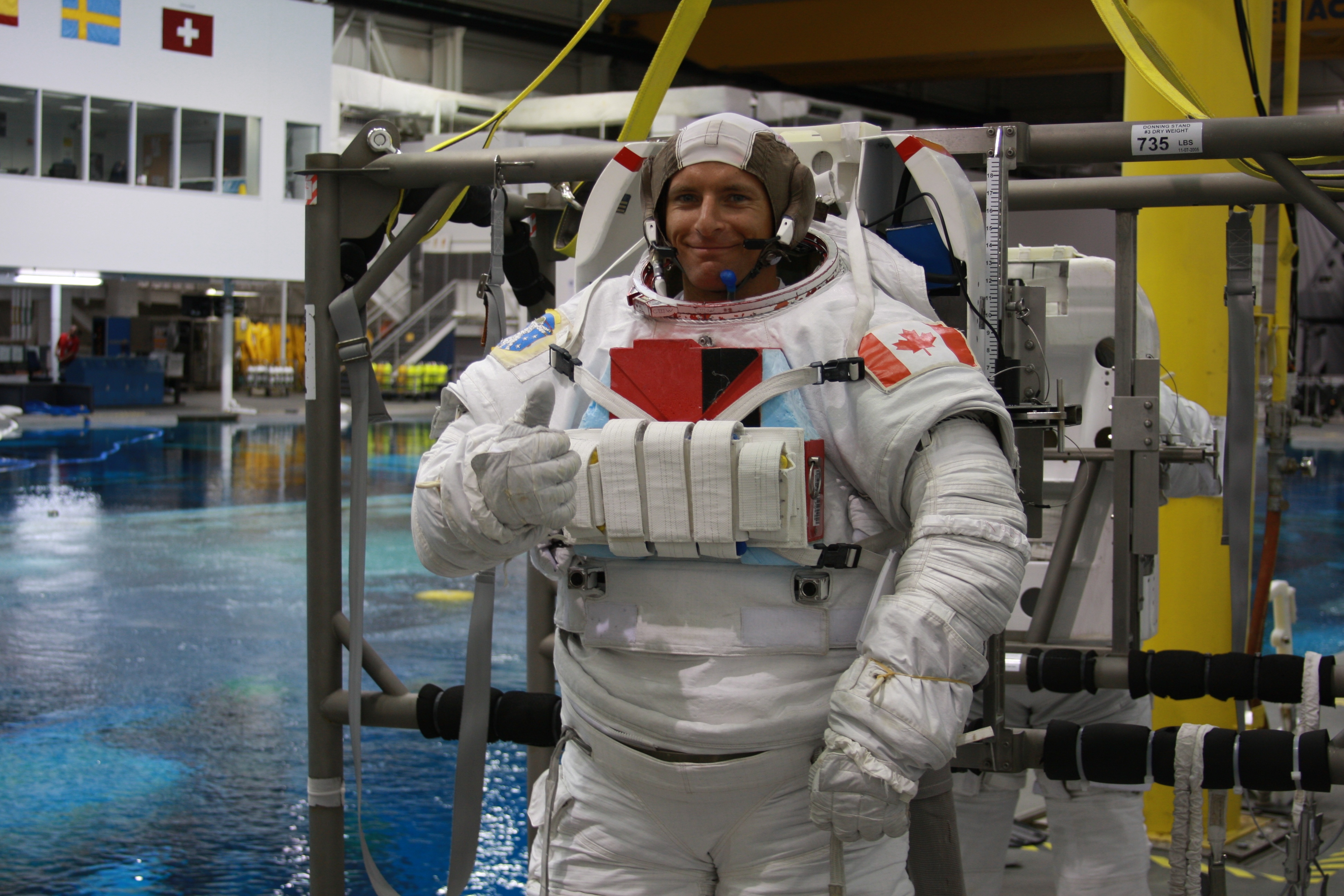
A fire breaks out on the International Space Station while the orbiting complex is over Russian mission control. How, as an English-speaking astronaut, would you keep up with instructions?
The answer is years of Russian training. In between time in simulators, jet airplanes and underwater, neophyte astronauts spend hours learning to read Cyrillic characters and pronounce consonant-heavy words. In fact, one of NASA’s requirements for its astronauts now is to learn the Russian language.
“It’s taken very seriously in the program because of the level you need to reach if, God forbid, there was an emergency on board and there was a panicky discussion going on in Russian on the radio,” Canadian astronaut and medical doctor David Saint-Jacques told Universe Today. “Ultimately, you need to be fluent to be really useful in a situation like that.”
Saint-Jacques himself is no neophyte to language learning. A native francophone, he learned English in public school and really improved it when he was 15 and moved with his family to England for a year. Today he speaks it fluently. He also has some abilities in Japanese, a language he picked up while in that country for a junior academic position at a university.
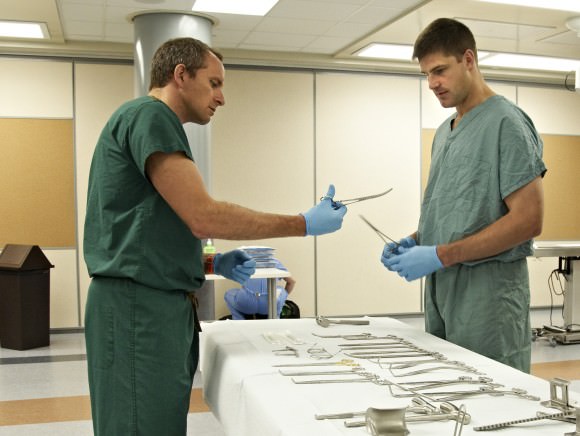
Now approaching four years as an astronaut trainee, Saint-Jacques told us how astronauts learn Russian. It’s a process that not only includes classroom instruction, but time living with a family in Moscow to really pick up on colloquialisms. Below is an edited interview.
What language training focuses on: “The point is not to write perfectly. The point is to communicate, similar to how businessmen learn languages. The emphasis for us is understanding spoken language, but the emphasis for us, the vocabulary, is different. I know all these obscure space hardware words and these crazy Russian space acronyms, but I may not know some of the flowers, for example. I can’t know everything.”
Basic Russian training: “We have Russian classes one-on-one with a Russian instructor. We get anything between one lesson every two weeks to three, four lessons a week, depending on how you accommodate the training schedule. Most astronauts want as much training as possible. It’s part of the requirements for basic training; you have to pass a certain competency test in Russian. There is a standard test that is used by the foreign affairs department, and so we do the same test. It’s a verbal test where you call the examiner on the phone and you have a discussion with them on the phone. If you pass a certain grade on that test, you are good to go.”
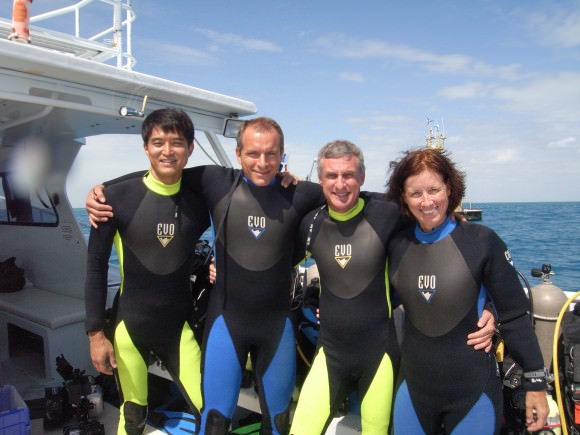
Living in Russia: “You have to go to Russia at some point to learn the Soyuz spacecraft and the Russian segment of space station. That, of course, is in all in Russian. The training is in Russian and the books are in Russian. There are translators that could be there with you, but you don’t want to rely on an interpreter for class. It really hits home; the more you know, the better. You will be living there for months, and it’s a no-brainer: you have to speak Russian when you are going to Russia.”
Immersion: “I took some holidays there [in Russia] with my family. That’s one of the great things when you speak the language of the country; you have fun there. I try to hang out with any Russian cosmonaut that comes here to Houston to keep up with them. There are two other ways we can train: you can block two to three weeks to do an intensive Russian test where all you want to do [beforehand] is study Russian. Also, when you are assigned to a spaceflight, in the year before your spaceflight, they [NASA] will try to send you for a month and a half in Moscow in a family for total immersion. That makes most people bump up their Russian level quite a lot.”
Side benefits: “It makes you realize how at the end of the day, international relations is really a form of personal relations, and speaking a language is absolutely fundamental. It makes you graduate from having a professional experience to a life experience with the other person, the other country.”
Soyuz Launches to Station amid Swirling Snowy Spectacular
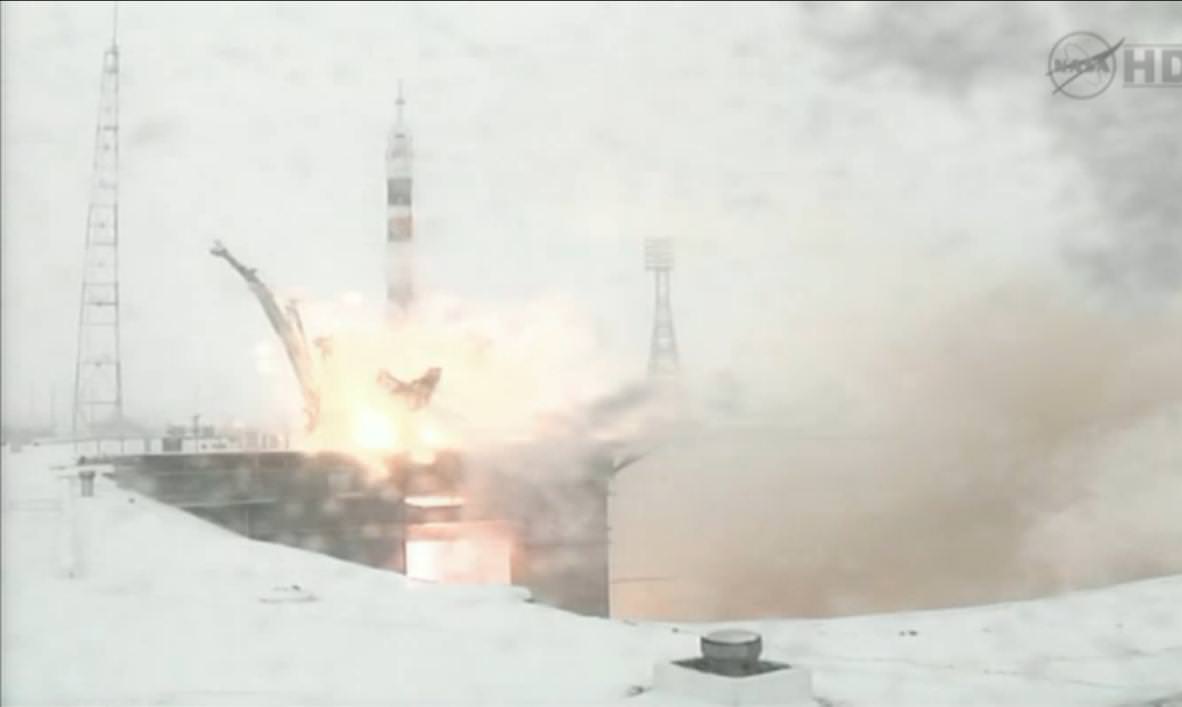
[/caption]
The future survival and fate of the International Space Station was on the line and is now firmly back on track following today’s (Nov. 13) successful, high stakes liftoff of a Russian Soyuz rocket carrying a three man crew of two Russians and one American bound for the orbiting research platform, amidst the backdrop of a spectacular snowstorm swirling about the Baikonur Cosmodrome in Kazakhstan – rare even by Russian standards.
The international crew comprises Expedition 29 Flight Engineer Dan Burbank from NASA – veteran of two prior shuttle missions to the station in 2000 and 2006 – and Anton Shkaplerov and Anatoly Ivanishin from Russia. It’s the rookie flight for both Russian cosmonauts.
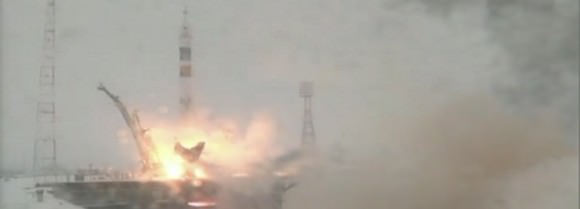
This is the first flight of a manned Soyuz-FG rocket – and of humans to space – since NASA’s Space Shuttle was forcibly retired in July and the subsequent failure of a virtually identical unmanned Soyuz-U booster in August which grounded all Russian flights to the ISS and threatened to potentially leave the station with no human presence aboard.
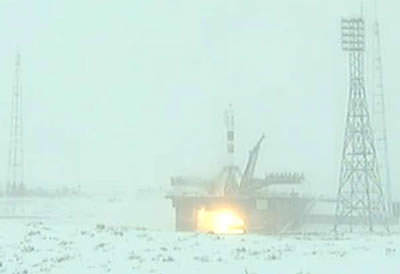
The trio of space flyers soared to the heavens at 11:14:03 p.m. EST Sunday Nov. 13 (11:14:03 a.m. Baikonur time Monday, Nov. 14) abroad their Soyuz TMA-22 capsule which was mounted atop the 50 meter tall Soyuz rocket.
Blastoff occurred precisely on time at about the time when the frigid, snow bedecked launch pad rotated into the plane of the orbit of the ISS. The launch was carried live on NASA TV and the ship quickly disappeared from view behind the nearly blinging blizzard.
The Soyuz TMA-22 achieved orbital insertion some nine minutes later into an initial 143 by 118 mile orbit, inclined 51 degrees to the equator.
The vehicles antennae’s and solar arrays were quickly deployed per plan and all spacecraft systems were functioning perfectly according to Russian Ground Control in Moscow.
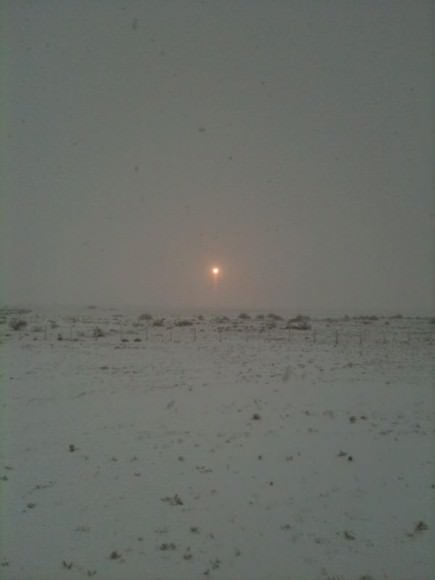
Following a two day orbital chase and three course correction burns the future ISS residents are due to dock at the Russian Poisk module at the complex at about 12:33 a.m. EST on Wednesday, Nov. 16.
In the hours prior to launch the crew received a religious blessing from the Russian Orthodox Church, took the bus for the 25 mile trip to the Cosmodrome, donned their white Sokol launch and entry suits and headed to the pad.
The crew boarded the capsule in the midst of an extremely heavy snow storm which struck the Baikonur region of Kazakhstan in the evening prior to launch. See photo from backup NASA astronaut Joe Acaba.
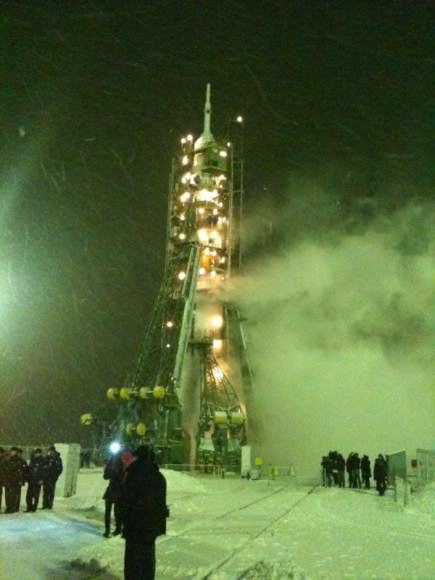
Although snow is quite common at this time of year, the blizzard conditions at launch time were actually quite rare according to NASA spokesman Rob Navias at Baikonur.
American rockets would never blast off in such severe weather conditions – but it’s nothing for the Russians!
The temperature was about 24 F, roughly 6 inches (15 cm) of snow had accumulated on the ground at launch time and moderate wind gusts partially obscured the view.
For the first time ever, a Soyuz crew was dressed in parkas – See Joe Acaba twitpic below !
Gantry towers were retracted from the three stage Soyuz booster at about T minus 25 minutes. The umbilical’s retracted in the final seconds.
The three stage Soyuz-FG rocket lifted off from Launch Pad 1 (LC-1), the same pad from which Cosmonaut Yuri Gagarin flew as the first human to space 50 Years ago this year. The pad is named “Gagarin Start” in honor of Gagarin’s courageous achievement on April 12, 1961.
The rocket was fueled with kerosene (RP-1) and cryogenic liquid oxygen.
The ISS was flying some 248 miles above the Pacific Ocean and just west of Chile at launch time.
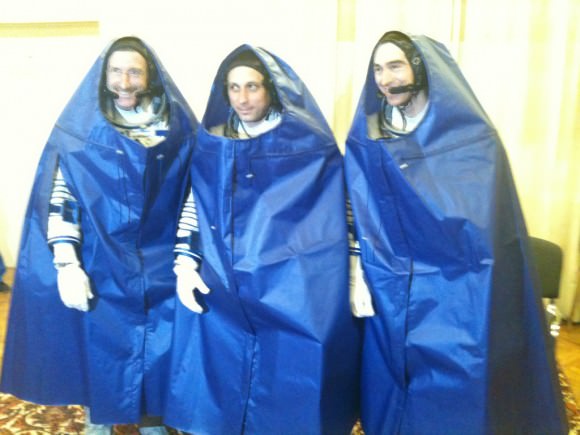
The importance of the TMA-22 mission cannot be overstated because it restored confidence in Russian rockets which now serve as the world’s only pathway for providing human access to the $100 Billion earth orbiting outpost.
The cramped Soyuz capsule measures just 2.2 m wide by 2.1 m high and weighs 2200 kg.
Today’s critical launch had been delayed be nearly two months from September 22, following the failure of a nearly identical Soyuz-U booster in August which was carrying the Progress 44 cargo resupply spacecraft and crashed ignominiously in Siberia after the third stage shut down unexpectedly.
The Progress 44 was loaded with nearly 3 tons of supplies and was bound for the ISS.
The third stage is nearly identical for both the manned and unmanned versions of the normally highly reliable Soyuz booster rocket.
The launch came only after a thorough review of the causes of the accident by a special State Commision- which was traced to a clogged fuel line – introduction of new quality control measures and careful inspection of all the engines.
“We have no doubt in our minds both the rocket and the vehicle are ready, all the activities have been done at the appropriate level of quality and reliability,” said Vladimir Popovkin, Head of Roscosmos, the Russian Federal Space Agency, prior to liftoff.
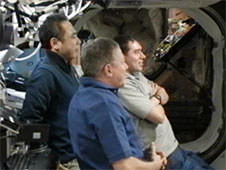
The new crew will join the other half of Expedition 29 already in residence aboard the ISS; Expedition 29 Commander Mike Fossum (NASA) and Flight Engineers Satoshi Furukawa (Japan) and Sergei Volkov (Russia). This will temporarily restore the ISS to a full complement of 6 crewmembers – but only for a few days.
Fossum will hand over command of the station to the new crew within four days. His crew departs the ISS for Earth reentry on Nov. 21.
The successful launch means that the ISS will not have to be left unmanned for the first time since continuous manned occupation began over 11 years ago and which would have placed the station at risk in case of failures requiring human intervention.
Burbank, Shkaplerov and Ivanishin will spend 5 months aboard the station. They will be joined in December by the next trio to round out Expedition 30
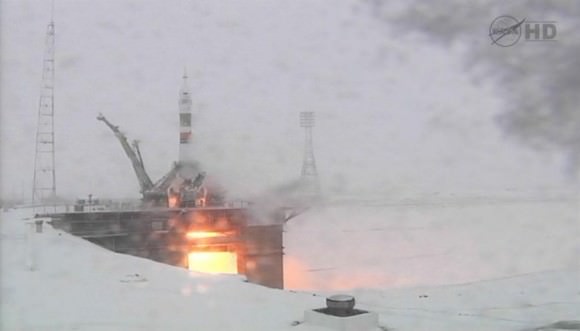
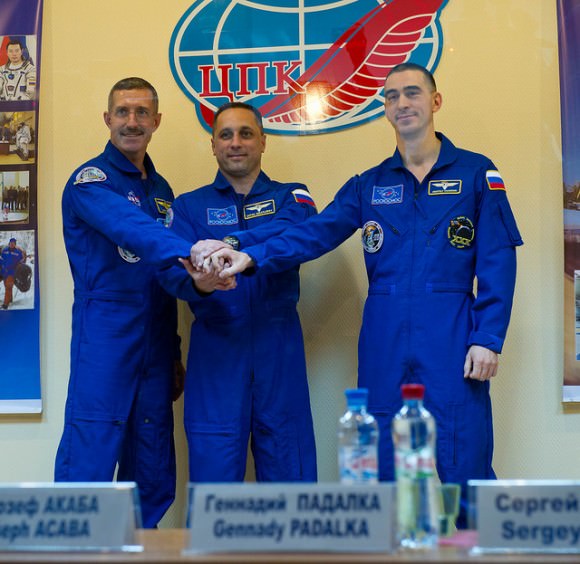
Read Ken’s continuing features about Russian Space Programs including Soyuz, Progress, Phobos-Grunt and Soyuz in South America starting here:
Soyuz Poised for High Stakes November 13 Blastoff – Space Stations Fate Hinges on Success
Success ! Launch Video of Crucial Russian Rocket to ISS puts Human Flights back on Track
Russians Race against Time to Save Ambitious Phobos-Grunt Mars Probe from Earthly Demise
Russia’s Bold Sample Return Mission to Mars and Phobos Blasts Off
Video Duet – Soyuz Debut Blast off from the Amazon Jungle and Rockin’ Russian Rollout !
Historic 1st Launch of Legendary Soyuz from South America
Russian Soyuz Poised for 1st Blastoff from Europe’s New South American Spaceport

